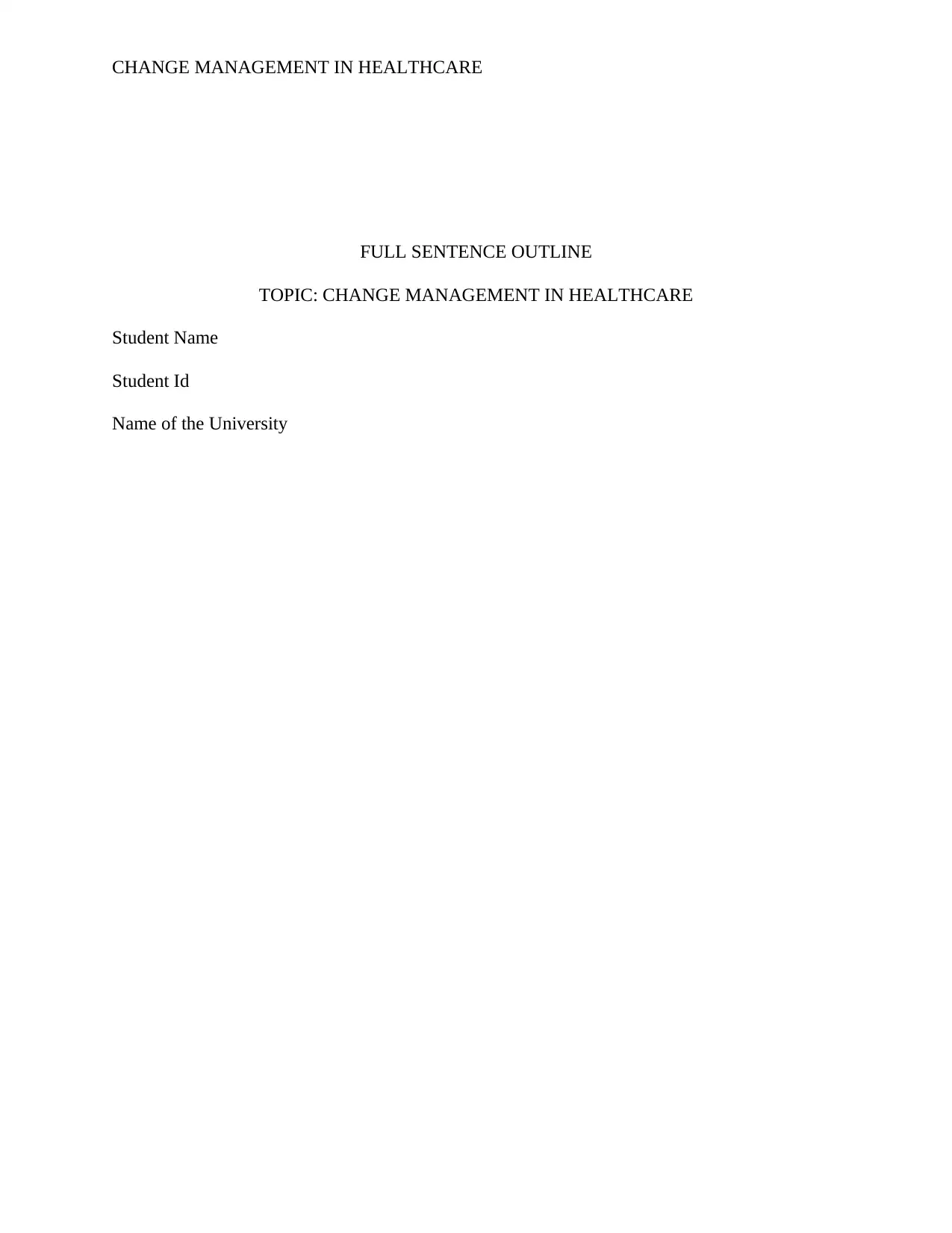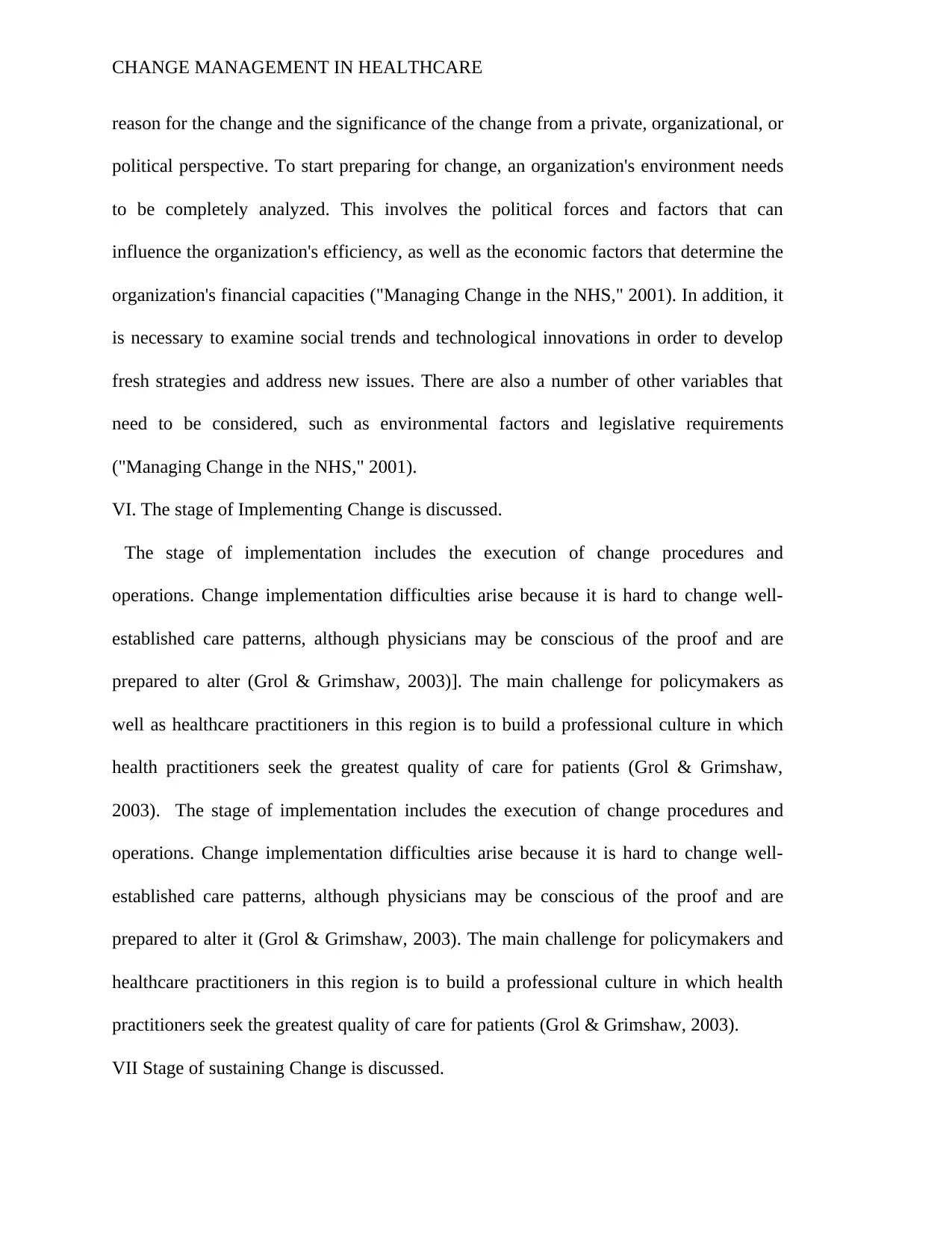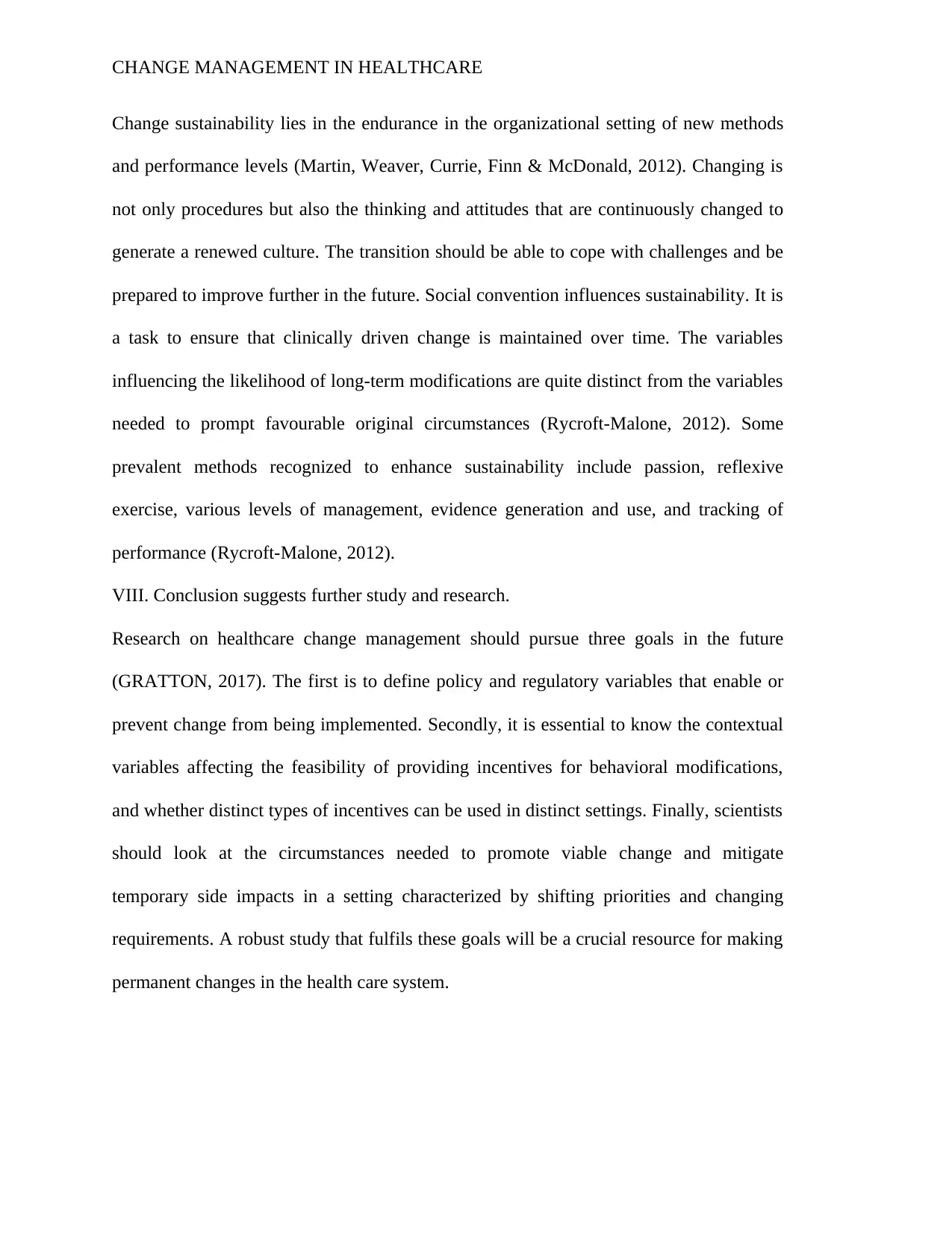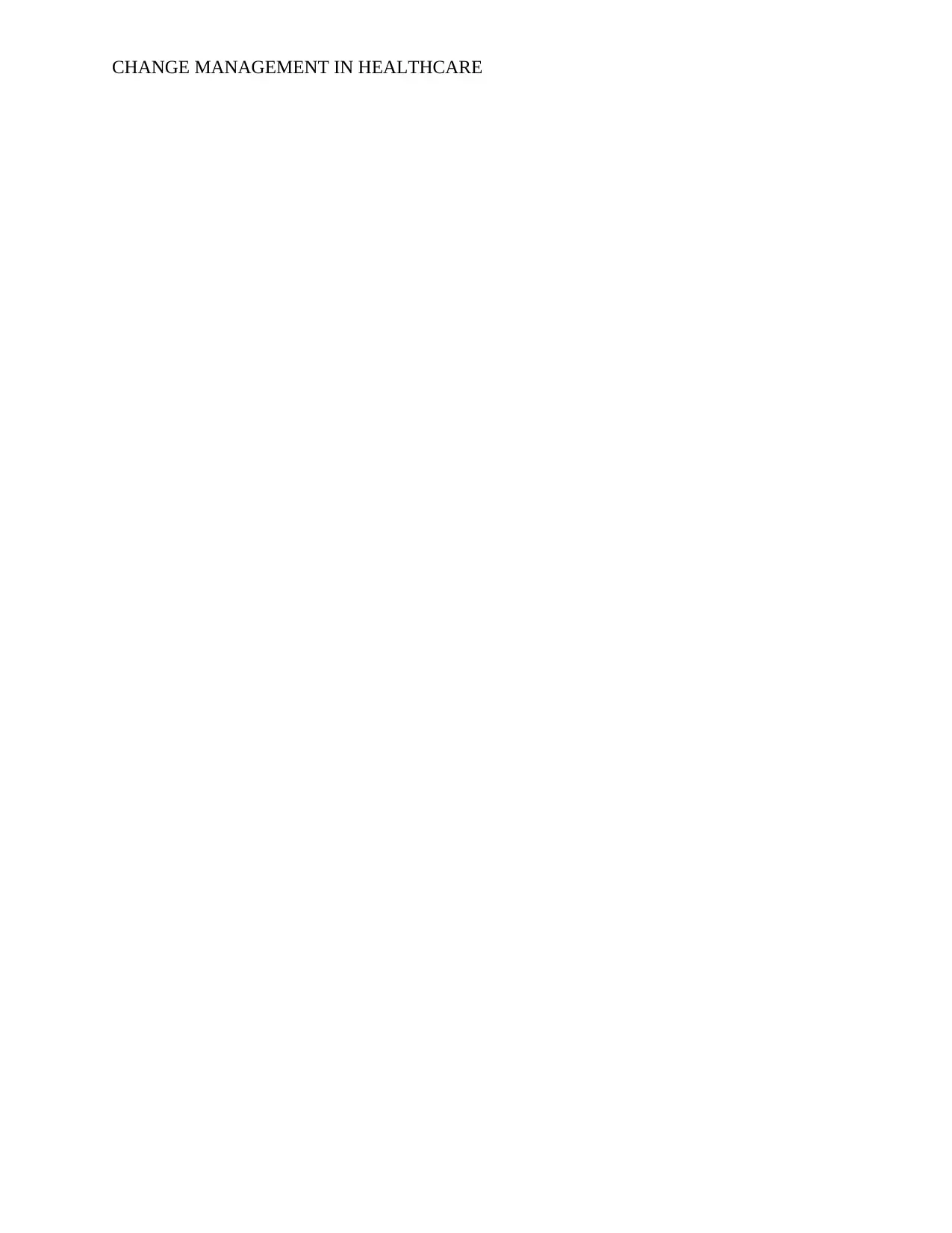Full Sentence Outline: Change Management in Healthcare
VerifiedAdded on 2022/12/27
|8
|1835
|91
Homework Assignment
AI Summary
This assignment presents a full-sentence outline exploring change management within the healthcare sector. The outline begins by highlighting the continuous changes in healthcare, driven by technology and evidence-based practices, and introduces the thesis statement: "Healthcare Transformation Leadership and Change Management." It then delves into the critical role of leadership in effecting change, emphasizing the importance of motivating, encouraging, and directing organizations toward actionable goals, and discusses the relevance of leadership theories. The outline further examines management theories supporting change, including transformative leadership and contingency theory, followed by an analysis of prominent management models. It then details the three mandatory stages of change management: preparing for change, implementing change, and sustaining change, discussing the critical factors in each stage. The conclusion suggests areas for future research, emphasizing policy, contextual variables, and sustainable change. The outline is supported by six references and follows APA format.

CHANGE MANAGEMENT IN HEALTHCARE
FULL SENTENCE OUTLINE
TOPIC: CHANGE MANAGEMENT IN HEALTHCARE
Student Name
Student Id
Name of the University
FULL SENTENCE OUTLINE
TOPIC: CHANGE MANAGEMENT IN HEALTHCARE
Student Name
Student Id
Name of the University
Paraphrase This Document
Need a fresh take? Get an instant paraphrase of this document with our AI Paraphraser

CHANGE MANAGEMENT IN HEALTHCARE
I Healthcare like other industries are continuously changing.
“Culture does not change because we desire to change it. Culture changes when the
organization is transformed – the culture reflects the realities of people working together
every day.” This is a famous quotation from Frances Hesselbein which explains the
impact of culture on change. With technology, healthcare is constantly changing and
protocols and policies are being implemented based on evidence-based methods.
Presently the healthcare world has made significant advancement in the delivery of
healthcare which is evidenced by the fact that our medical records are electronic and
patients can interact through telecare with their suppliers. Change is seen as beneficial
for most individuals in the medical sector: shorter waiting times in the hospital, easier
access to health records, and better communication between patients and their suppliers.
Some individuals still refuse to enforce change because of fear of the unknown and the
convenience of how things are going before the modifications. If we can provide some
favorable outlooks and proof to individuals who are unwilling to change, they may be
more prepared to modify their attitudes and enforce the changes. To analyze the Impact
of Change in Healthcare, the first subject to come up is cost involved and advantages
when speaking about change in healthcare system. Any change management in the
healthcare industry should, therefore, be backed by the long-term advantages that should
justify the change. My thesis statement is "Healthcare Transformation Leadership and
Change Management."
II. Role of leadership is important for effecting change in healthcare.
Leadership is said to be efficient if it helps the organization of health care attain its
objectives and attain results that are compatible with the majority. The quality to be
I Healthcare like other industries are continuously changing.
“Culture does not change because we desire to change it. Culture changes when the
organization is transformed – the culture reflects the realities of people working together
every day.” This is a famous quotation from Frances Hesselbein which explains the
impact of culture on change. With technology, healthcare is constantly changing and
protocols and policies are being implemented based on evidence-based methods.
Presently the healthcare world has made significant advancement in the delivery of
healthcare which is evidenced by the fact that our medical records are electronic and
patients can interact through telecare with their suppliers. Change is seen as beneficial
for most individuals in the medical sector: shorter waiting times in the hospital, easier
access to health records, and better communication between patients and their suppliers.
Some individuals still refuse to enforce change because of fear of the unknown and the
convenience of how things are going before the modifications. If we can provide some
favorable outlooks and proof to individuals who are unwilling to change, they may be
more prepared to modify their attitudes and enforce the changes. To analyze the Impact
of Change in Healthcare, the first subject to come up is cost involved and advantages
when speaking about change in healthcare system. Any change management in the
healthcare industry should, therefore, be backed by the long-term advantages that should
justify the change. My thesis statement is "Healthcare Transformation Leadership and
Change Management."
II. Role of leadership is important for effecting change in healthcare.
Leadership is said to be efficient if it helps the organization of health care attain its
objectives and attain results that are compatible with the majority. The quality to be

CHANGE MANAGEMENT IN HEALTHCARE
consistent is the overall qualities necessary for leadership to be effective in the hospital;
the need to motivate, encourage, support and direct the organization to achieve actionable
goals. Whatever is debatable, however, is how leaders obtain these needed
characteristics, the discussion focuses on whether leadership abilities are innate or can be
obtained, and which leadership styles tend to be most efficient in certain environments.
Leadership is said to be efficient if it helps the organization of health care attain its
objectives and attain results that are compatible with the majority. The quality to be
consistent is the overall qualities necessary for leadership to be effective in the hospital;
the need to motivate, encourage, support and direct the organization to achieve actionable
goals.
III. The management theory supports change in healthcare setup.
The assessment will be rooted in formal management theory to investigate the kinds of
leaders that exist and are efficient in healthcare, particularly transformative leadership,
and the abilities and talents that leaders should need to create efficient service industries.
The literature surrounding leadership seems to argue that the required characteristics and
abilities may be either born with or created, the sort of management that exists appears to
demonstrate a variety of hypotheses. What is evident, however, is that transformation
leadership is viewed by nursing literature as a significant element of change management,
and some writers have recognized this leadership style as one of the most efficient
procedures that can contribute to long-term effectiveness. The combination of leadership,
change management and associated theories of nurse management offers an outstanding
platform to examine activities in a healthcare setting. The problem of governance and
management is tightly intertwined, but it is evident that there are many problems that
consistent is the overall qualities necessary for leadership to be effective in the hospital;
the need to motivate, encourage, support and direct the organization to achieve actionable
goals. Whatever is debatable, however, is how leaders obtain these needed
characteristics, the discussion focuses on whether leadership abilities are innate or can be
obtained, and which leadership styles tend to be most efficient in certain environments.
Leadership is said to be efficient if it helps the organization of health care attain its
objectives and attain results that are compatible with the majority. The quality to be
consistent is the overall qualities necessary for leadership to be effective in the hospital;
the need to motivate, encourage, support and direct the organization to achieve actionable
goals.
III. The management theory supports change in healthcare setup.
The assessment will be rooted in formal management theory to investigate the kinds of
leaders that exist and are efficient in healthcare, particularly transformative leadership,
and the abilities and talents that leaders should need to create efficient service industries.
The literature surrounding leadership seems to argue that the required characteristics and
abilities may be either born with or created, the sort of management that exists appears to
demonstrate a variety of hypotheses. What is evident, however, is that transformation
leadership is viewed by nursing literature as a significant element of change management,
and some writers have recognized this leadership style as one of the most efficient
procedures that can contribute to long-term effectiveness. The combination of leadership,
change management and associated theories of nurse management offers an outstanding
platform to examine activities in a healthcare setting. The problem of governance and
management is tightly intertwined, but it is evident that there are many problems that
⊘ This is a preview!⊘
Do you want full access?
Subscribe today to unlock all pages.

Trusted by 1+ million students worldwide

CHANGE MANAGEMENT IN HEALTHCARE
distinguish the two. Organizational results are generally regarded to be the mixture of
inherent values and learnings, according to Sturm (Sturm, 2009). The significance of the
leadership and management framework of the organization is due to the reality that it
promotes operational excellence and guarantees the achievement of strategic goals.
IV. Prominent management models support change management.
In reality, it has been discovered that many leaders do not have all or a majority of the
alleged characteristics that determine whether a person is a good leader, while
contingency theory, on the other side, defines a leader based on the assignment or
solution that is generally defining abilities based on environmental or situational
variables. The initial management model of Fiedler indicated that there were two
management styles; task-oriented or relationship-oriented. (Peters, Pohlmann & Hartke,
1985). Callaghan used this template (Callaghan, 2008), recognized as one of the first
contingency models as it concentrated on the degree to which the assignment was
structured and the organizational authority of the leader. Fiedler's model demonstrates
that the capacity of the leader is based on the preferred style of the leader and the
followers ' motivation, that is, the leaders ' efficacy has to do with how well the leader's
style matches the condition. Callaghan showed that the two fundamental styles of
management are task-oriented, where the focus is on accomplishment and person-
oriented relationships, where the leader focuses on excellent private relationships.
V. Change management undergoes three mandatory stages and stage relating to preparing
for change is discussed.
This phase is to facilitate the mental preparation needed for effective change (NHS
Management Change, 2001). It is essential for the decision-maker to understand the
distinguish the two. Organizational results are generally regarded to be the mixture of
inherent values and learnings, according to Sturm (Sturm, 2009). The significance of the
leadership and management framework of the organization is due to the reality that it
promotes operational excellence and guarantees the achievement of strategic goals.
IV. Prominent management models support change management.
In reality, it has been discovered that many leaders do not have all or a majority of the
alleged characteristics that determine whether a person is a good leader, while
contingency theory, on the other side, defines a leader based on the assignment or
solution that is generally defining abilities based on environmental or situational
variables. The initial management model of Fiedler indicated that there were two
management styles; task-oriented or relationship-oriented. (Peters, Pohlmann & Hartke,
1985). Callaghan used this template (Callaghan, 2008), recognized as one of the first
contingency models as it concentrated on the degree to which the assignment was
structured and the organizational authority of the leader. Fiedler's model demonstrates
that the capacity of the leader is based on the preferred style of the leader and the
followers ' motivation, that is, the leaders ' efficacy has to do with how well the leader's
style matches the condition. Callaghan showed that the two fundamental styles of
management are task-oriented, where the focus is on accomplishment and person-
oriented relationships, where the leader focuses on excellent private relationships.
V. Change management undergoes three mandatory stages and stage relating to preparing
for change is discussed.
This phase is to facilitate the mental preparation needed for effective change (NHS
Management Change, 2001). It is essential for the decision-maker to understand the
Paraphrase This Document
Need a fresh take? Get an instant paraphrase of this document with our AI Paraphraser

CHANGE MANAGEMENT IN HEALTHCARE
reason for the change and the significance of the change from a private, organizational, or
political perspective. To start preparing for change, an organization's environment needs
to be completely analyzed. This involves the political forces and factors that can
influence the organization's efficiency, as well as the economic factors that determine the
organization's financial capacities ("Managing Change in the NHS," 2001). In addition, it
is necessary to examine social trends and technological innovations in order to develop
fresh strategies and address new issues. There are also a number of other variables that
need to be considered, such as environmental factors and legislative requirements
("Managing Change in the NHS," 2001).
VI. The stage of Implementing Change is discussed.
The stage of implementation includes the execution of change procedures and
operations. Change implementation difficulties arise because it is hard to change well-
established care patterns, although physicians may be conscious of the proof and are
prepared to alter (Grol & Grimshaw, 2003)]. The main challenge for policymakers as
well as healthcare practitioners in this region is to build a professional culture in which
health practitioners seek the greatest quality of care for patients (Grol & Grimshaw,
2003). The stage of implementation includes the execution of change procedures and
operations. Change implementation difficulties arise because it is hard to change well-
established care patterns, although physicians may be conscious of the proof and are
prepared to alter it (Grol & Grimshaw, 2003). The main challenge for policymakers and
healthcare practitioners in this region is to build a professional culture in which health
practitioners seek the greatest quality of care for patients (Grol & Grimshaw, 2003).
VII Stage of sustaining Change is discussed.
reason for the change and the significance of the change from a private, organizational, or
political perspective. To start preparing for change, an organization's environment needs
to be completely analyzed. This involves the political forces and factors that can
influence the organization's efficiency, as well as the economic factors that determine the
organization's financial capacities ("Managing Change in the NHS," 2001). In addition, it
is necessary to examine social trends and technological innovations in order to develop
fresh strategies and address new issues. There are also a number of other variables that
need to be considered, such as environmental factors and legislative requirements
("Managing Change in the NHS," 2001).
VI. The stage of Implementing Change is discussed.
The stage of implementation includes the execution of change procedures and
operations. Change implementation difficulties arise because it is hard to change well-
established care patterns, although physicians may be conscious of the proof and are
prepared to alter (Grol & Grimshaw, 2003)]. The main challenge for policymakers as
well as healthcare practitioners in this region is to build a professional culture in which
health practitioners seek the greatest quality of care for patients (Grol & Grimshaw,
2003). The stage of implementation includes the execution of change procedures and
operations. Change implementation difficulties arise because it is hard to change well-
established care patterns, although physicians may be conscious of the proof and are
prepared to alter it (Grol & Grimshaw, 2003). The main challenge for policymakers and
healthcare practitioners in this region is to build a professional culture in which health
practitioners seek the greatest quality of care for patients (Grol & Grimshaw, 2003).
VII Stage of sustaining Change is discussed.

CHANGE MANAGEMENT IN HEALTHCARE
Change sustainability lies in the endurance in the organizational setting of new methods
and performance levels (Martin, Weaver, Currie, Finn & McDonald, 2012). Changing is
not only procedures but also the thinking and attitudes that are continuously changed to
generate a renewed culture. The transition should be able to cope with challenges and be
prepared to improve further in the future. Social convention influences sustainability. It is
a task to ensure that clinically driven change is maintained over time. The variables
influencing the likelihood of long-term modifications are quite distinct from the variables
needed to prompt favourable original circumstances (Rycroft-Malone, 2012). Some
prevalent methods recognized to enhance sustainability include passion, reflexive
exercise, various levels of management, evidence generation and use, and tracking of
performance (Rycroft-Malone, 2012).
VIII. Conclusion suggests further study and research.
Research on healthcare change management should pursue three goals in the future
(GRATTON, 2017). The first is to define policy and regulatory variables that enable or
prevent change from being implemented. Secondly, it is essential to know the contextual
variables affecting the feasibility of providing incentives for behavioral modifications,
and whether distinct types of incentives can be used in distinct settings. Finally, scientists
should look at the circumstances needed to promote viable change and mitigate
temporary side impacts in a setting characterized by shifting priorities and changing
requirements. A robust study that fulfils these goals will be a crucial resource for making
permanent changes in the health care system.
Change sustainability lies in the endurance in the organizational setting of new methods
and performance levels (Martin, Weaver, Currie, Finn & McDonald, 2012). Changing is
not only procedures but also the thinking and attitudes that are continuously changed to
generate a renewed culture. The transition should be able to cope with challenges and be
prepared to improve further in the future. Social convention influences sustainability. It is
a task to ensure that clinically driven change is maintained over time. The variables
influencing the likelihood of long-term modifications are quite distinct from the variables
needed to prompt favourable original circumstances (Rycroft-Malone, 2012). Some
prevalent methods recognized to enhance sustainability include passion, reflexive
exercise, various levels of management, evidence generation and use, and tracking of
performance (Rycroft-Malone, 2012).
VIII. Conclusion suggests further study and research.
Research on healthcare change management should pursue three goals in the future
(GRATTON, 2017). The first is to define policy and regulatory variables that enable or
prevent change from being implemented. Secondly, it is essential to know the contextual
variables affecting the feasibility of providing incentives for behavioral modifications,
and whether distinct types of incentives can be used in distinct settings. Finally, scientists
should look at the circumstances needed to promote viable change and mitigate
temporary side impacts in a setting characterized by shifting priorities and changing
requirements. A robust study that fulfils these goals will be a crucial resource for making
permanent changes in the health care system.
⊘ This is a preview!⊘
Do you want full access?
Subscribe today to unlock all pages.

Trusted by 1+ million students worldwide

CHANGE MANAGEMENT IN HEALTHCARE
References
Callaghan, G. (2008). Evaluation and Negotiated Order. Evaluation, 14(4), 399-411. doi:
10.1177/1356389008095485
GRATTON, L. (2017). CHANGE MANAGEMENT. London Business School
Review, 28(2), 28-31. doi: 10.1111/2057-1615.12171
Grol, R., & Grimshaw, J. (2003). From best evidence to best practice: effective implementation
of change in patients' care. The Lancet, 362(9391), 1225-1230. doi: 10.1016/s0140-
6736(03)14546-1
Managing Change in the NHS. (2001). Retrieved from
http://www.netscc.ac.uk/hsdr/files/adhoc/change-management-review.pdf
Martin, G., Weaver, S., Currie, G., Finn, R., & McDonald, R. (2012). Innovation sustainability in
challenging health-care contexts: Embedding clinically led change in routine
practice. Health Services Management Research, 25(4), 190-199. doi:
10.1177/0951484812474246
Peters, L., Hartke, D., & Pohlmann, J. (1985). Fiedler's Contingency Theory of
Leadership: An application of the meta-analysis procedures of Schmidt and
Hunter. Psychological Bulletin, 97(2), 274-285. doi: 10.1037//0033-
2909.97.2.274
Rycroft-Malone, J. (2012). Implementing Evidence-Based Practice in the Reality of Clinical
Practice. Worldviews On Evidence-Based Nursing, 9(1), 1-1. doi: 10.1111/j.1741-
6787.2011.00240.x
Sturm, B. (2009). Principles of Servant-Leadership in Community Health Nursing. Home
Health Care Management & Practice, 21(2), 82-89. doi:
10.1177/1084822308318187
References
Callaghan, G. (2008). Evaluation and Negotiated Order. Evaluation, 14(4), 399-411. doi:
10.1177/1356389008095485
GRATTON, L. (2017). CHANGE MANAGEMENT. London Business School
Review, 28(2), 28-31. doi: 10.1111/2057-1615.12171
Grol, R., & Grimshaw, J. (2003). From best evidence to best practice: effective implementation
of change in patients' care. The Lancet, 362(9391), 1225-1230. doi: 10.1016/s0140-
6736(03)14546-1
Managing Change in the NHS. (2001). Retrieved from
http://www.netscc.ac.uk/hsdr/files/adhoc/change-management-review.pdf
Martin, G., Weaver, S., Currie, G., Finn, R., & McDonald, R. (2012). Innovation sustainability in
challenging health-care contexts: Embedding clinically led change in routine
practice. Health Services Management Research, 25(4), 190-199. doi:
10.1177/0951484812474246
Peters, L., Hartke, D., & Pohlmann, J. (1985). Fiedler's Contingency Theory of
Leadership: An application of the meta-analysis procedures of Schmidt and
Hunter. Psychological Bulletin, 97(2), 274-285. doi: 10.1037//0033-
2909.97.2.274
Rycroft-Malone, J. (2012). Implementing Evidence-Based Practice in the Reality of Clinical
Practice. Worldviews On Evidence-Based Nursing, 9(1), 1-1. doi: 10.1111/j.1741-
6787.2011.00240.x
Sturm, B. (2009). Principles of Servant-Leadership in Community Health Nursing. Home
Health Care Management & Practice, 21(2), 82-89. doi:
10.1177/1084822308318187
Paraphrase This Document
Need a fresh take? Get an instant paraphrase of this document with our AI Paraphraser

CHANGE MANAGEMENT IN HEALTHCARE
1 out of 8
Related Documents
Your All-in-One AI-Powered Toolkit for Academic Success.
+13062052269
info@desklib.com
Available 24*7 on WhatsApp / Email
![[object Object]](/_next/static/media/star-bottom.7253800d.svg)
Unlock your academic potential
Copyright © 2020–2025 A2Z Services. All Rights Reserved. Developed and managed by ZUCOL.





